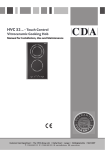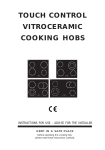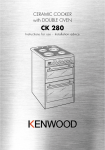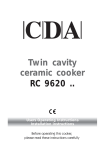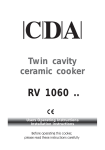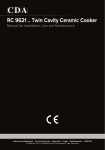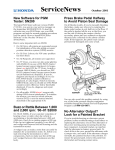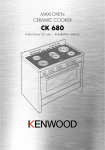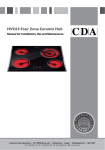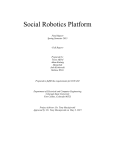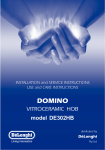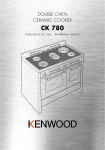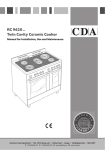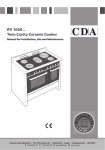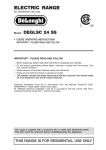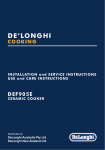Download CDA HVC60SS hob
Transcript
VITROCERAMIC COOKING HOBS INSTRUCTIONS FOR USE - ADVICE FOR THE INSTALLER KEEP IN A SAFE PLACE Before operating this cooking hob, please read these instructions carefully Dear Customer, Thank you for having purchased and given your preference to our product. The safety precautions and recommendations reported below are for your own safety and that of others. They will also provide a means by which to make full use of the features offered by your appliance. Please preserve this booklet carefully. It may be useful in future, either to yourself or to others in the event that doubts should arise relating to its operation. This appliance must be used only for the task it has explicitly been designed for, that is for cooking foodstuffs. Any other form of usage is to be considered as inappropriate and therefore dangerous. The manufacturer declines all responsibility in the event of damage caused by improper, incorrect or illogical use of the appliance. CE Declaration of conformity • This hob has been designed for use only as a cooking appliance. Any other use (e.g. heating rooms) should be considered incorrect and therefore dangerous. • This hob has been designed, constructed and put on to the market in conformity with: - Safety requirements of the "Low Voltage" Directive 73/23/EEC; - Protection requirements of the "EMC" Directive 89/336/EEC; - Requirements of Directive 93/68/EEC. IMPORTANT INFORMATION FOR CORRECT DISPOSAL OF THE PRODUCT IN ACCORDANCE WITH EC DIRECTIVE 2002/96/EC. At the end of its working life, the product must not be disposed of as urban waste. It must be taken to a special local authority differentiated waste collection centre or to a dealer providing this service. Disposing of a household appliance separately avoids possible negative consequences for the environment and health deriving from inappropriate disposal and enables the constituent materials to be recovered to obtain significant savings in energy and resources. As a reminder of the need to dispose of household appliances separately, the product is 2 marked with a crossed-out wheeled dustbin. BEFORE USING FOR THE FIRST TIME • Read the instructions carefully before installing and using the appliance • After unpacking the appliance, make sure it is not damaged. In case of doubt, do not use the appliance and contact your supplier or a qualified engineer. • Remove all packaging and do not leave the packing material (plastic bags, polystyrene, bands etc ) in easy reach of children as they may cause serious injury. The packaging materials are recyclable. • The appliance should be installed and all the electrical connections made by a qualified engineer in compliance with local regulations in force and following the manufacturer’s instructions. • Do not attempt to modify the technical properties of the appliance, as it may become dangerous to use. IMPORTANT SAFEGUARDS & RECOMMENDATIONS • Do not carry out any cleaning or maintenance without first disconnecting the appliance from the electrical supply. • During and after use of the hob, certain parts will become very hot. Do not touch hot parts. • After use always ensure that the control knobs are in the OFF position. • Young children should be supervised to ensure that they do not play with the appliance. • Keep children away from the hob during use. • The appliance is not intended for use by young children or infirm persons unless they have been adequately supervised by a responsible person to ensure that they can use the appliance safely. • Do not allow young children or infirm persons to use the appliance without your supervision. • WARNING When correctly installed, your product meets all safety requirements laid down for this type of product category. However special care should be taken around the underneath of the appliance as this area is not designed or intended to be touched and may contain sharp or rough edges, that may cause injury. • Fire Risk! Do not leave inflammable materials on the Hob top. • Make sure that electrical cords connecting other appliances in the proximity cannot come in to contact with the Hob top. • Do not allow heavy or sharp objects to drop on the glass ceramic hob. If the hob is cracked or damaged , unplug and call the after-sales service. • Do not scratch the hob with sharp objects. Don’t use the hob as a work surface. • Before disposing of an unwanted appliance, it is recommended that it is made inoperative and that all potentially hazardous parts are made harmless. • Important: This appliance has been designed for domestic use only. The appliance is NOT suitable for use within a semi-commercial, commercial or communal environment. • If the supply cord is damaged, it must be replaced by the manufacturer or its service agent or a similarly qualified person in order to avoid a hazard. 3 1 FEATURES 60 cm models 2 3 1 4 2 3 1 Fig. 1.2 Fig. 1.1 5 6 7 9 8 10 5 6 7 9 8 10 Electrical insulation Class I Electrical insulation Class I COOKING POINTS (Fig. 1.1) COOKING POINTS (Fig. 1.2) 1. Hi-light cooking zone Ø 140 mm - 1200 W 2. Hi-light cooking zone Ø 210 mm - 2300 W 3. Double hi-light cooking zone Ø 210/120 mm - 2200/750 W 4. Hi-light cooking zone Ø 140 mm - 1200 W CONTROLS DESCRIPTION 5. Left front zone (1) control knob 6. Left rear zone (2) control knob 7. Right rear zone (3) control knob 8. Right front zone (4) control knob 9. Residual heat indicators 10. Power on indicator light 4 4 1. Hi-light cooking zone Ø 180 mm - 1800 W 2. Hi-light cooking zone Ø 140 mm - 1200 W 3. Hi-light cooking zone Ø 180 mm - 1800 W 4. Hi-light cooking zone Ø 140 mm - 1200 W CONTROLS DESCRIPTION 5. Left front zone (1) control knob 6. Left rear zone (2) control knob 7. Right rear zone (3) control knob 8. Right front zone (4) control knob 9. Residual heat indicators 10. Power on indicator light 80 cm models 3 2 4 1 Fig. 1.3 5 6 7 9 8 10 Electrical insulation Class I COOKING POINTS (Fig. 1.3) 1. Hi-light cooking zone Ø 140 mm - 1200 W 2. Oval double hi-light cooking zone Ø 180 x 260 mm - 800/2200 W 3. Hi-light cooking zone Ø 140 mm - 1200 W 4. Double hi-light cooking zone Ø 210/120 mm - 2200/750 W CONTROLS DESCRIPTION 5. Left front zone (1) control knob 6. Left rear zone (2) control knob 7. Right rear zone (3) control knob 8. Right front zone (4) control knob 9. Residual heat indicators 10. Power on indicator light 5 90 cm models 2 4 3 1 5 Fig. 1.4 6 7 8 11 9 10 12 Electrical insulation Class I COOKING POINTS (Fig. 1.4) 1. Hi-light cooking zone Ø 180 mm - 1800 W 2. Hi-light cooking zone Ø 140 mm - 1200 W 3. Oval double hi-light cooking zone Ø 180 x 260 mm - 800/2200 W 4. Double hi-light cooking zone Ø 210/120 mm - 2200/750 W 5. Hi-light cooking zone Ø 140 mm - 1200 W CONTROLS DESCRIPTION 6. Left front zone (1) control knob 7. Left rear zone (2) control knob 8. Central zone (3) control knob 9. Right rear zone (4) control knob 10. Right front zone (5) control knob 11. Residual heat indicators 12. Power on indicator light 6 2 HOW TO USE THE HOB The ceramic surface of the hob allows a fast transmission of heat in the vertical direction, from the heating elements underneath the ceramic glass to the pans set on it. The heat does not spread in a horizontal direction, so that the glass stays “cool” at only a few centimeters from the cooking plate. The cooking zones are shown by painted disks on the ceramic surface. Before switching on the cooktop make sure that it is clean. IMPORTANT NOTE: The heating elements incorporate a thermolimiter that switches the element ON/OFF during all settings to protect the ceramic glass from overheating. The use of incorrect pans and/or wrong pan positioning will cause the temperature limiter to operate more frequently, resulting in a reduction of cooking performance. The temperature limiter can be seen under the glass dissecting the element. This is not a fault with the appliance. HI-LIGHT RADIANT ZONES (Fig. 2.1) The heating element is formed of a coil of resistant material which reaches the working temperature quickly. These zones are controlled by a continuous energy regulator switch (figs. 2.2a - 2.2b). The heat intensity can be regulated continuously from “0” to “12” (max). Check that the hob is clean and then switch on by turning the control knob. When the hob is working, the pilot light will be on. Fig. 2.2a Hi-light cooking zone Ø 140 mm Hi-light cooking zone Ø 180 mm Hi-light cooking zone Ø 210 mm Fig. 2.1 Fig. 2.2b 7 HI-LIGHT DOUBLE ZONE and HI-LIGHT OVAL ZONES The heating element is formed of a 2 coils of resistant material which reaches the working temperature quickly. These zones are controlled by a continuous energy regulator switch (figs. 2.3a - 2.3b). The heat intensity can be regulated continuously from “0” to “12” (max). Check that the hob is clean and then switch on by turning the control knob. When the hob is working, the pilot light will be on. By switching on the second element (fig. 2.4), the surface area of the double and oval hilight zones can be extended. For this purpose, turn the control knob (figs. 2.3a - 2.3b) fully to the right (position Fig. 2.3a Fig. 2.3b Second element Hi-light double zone 8 Fig. 2.4 Hi-light oval double zone ). CO0KING HINTS Cooking zone knob setting Knob setting TYPE OF COOKING 0 Switched OFF 1 2 For melting operations (butter, chocolate). 2 3 4 To maintain food hot and to heat small quantities of liquid (sauces, eggs). 4 5 6 To heat bigger quantities; to whip creams and sauces. (vegetables, fruits, soups). 6 7 Slow boiling, i.e.: meats, spaghetti, continuations of cooking of roasts, potatoes. 7 8 For every kind of frying, cutlets, uncovered cooking, i.e.: risotto. 8 9 10 Browning of meats, roasted potatoes, fried fish, omelettes, and for boiling large quantities of water. 11 12 Fast frying, grilled steaks, etc. 1 2 3 4 5 6 7 boiled soups, steam stews, 8 9 10 11 12 Heating Switching on the second element (Double and oval zones only) Cooking Roasting-frying Fig. 2.5 After a short period of use, experience will teach you which setting is the right one for your needs. 9 RESIDUAL HEAT INDICATORS The hob also features 4 or 5 warning lamps which are wired to the corresponding plate. When the temperature of a cooking plate is over 60°C, the relevant warning lamp is also litup to warn of heat on the surface of the hob. These lamps also stay on after the cooking plates have been switched off to shown that the hob surface is still hot. This residual heat will lasts for a long time after the cooking plate has been switched off. During this time you should avoid touching the hob surface over the cooking area. Please pay special attention to ensure that children are not allowed near the hob. Fig. 2.6 The lamps will switch off automatically as soon as the surface temperature of the cooking zone falls below 60°C. COOKING HINTS – To reduce the cooking time, you can turn the control knob to the max when you switch the plate on. After a short time you will set the control knob to the required position for the cooking. – You should use pots and pans with flat bases (pans with the test mark for glassceramic hobs are available from specialist shops). – The diameter of the pan should match that of the cooking plate (or be slightly bigger) to make the most of the energy. – Since the cooking surface stays hot for a certain time after the plate has been switched off, you can switch it off 5 or 10 minutes before the end of the cooking. The residual heat of the hob will complete the cooking. – To save electricity, use pan lids whenever possible. Never cook the food directly on the glass ceramic cooktop, but in special pans or containers. WARNING: Hobs become very hot with use, and retain their heat for a long time after cooking has finished (about 30 minutes). Children should be supervised at all times and be prevented from touching the hot surfaces, until such time as the appliance has cooled. 10 SAFETY HINTS • Before you switch the hob on, make sure you know which knob controls the required cooking zone. We advise you to set the pan over the cooking zone before switching it on. DISTORTED PANBASE • Do not use pots and pans with rough bases (pay attention to cookware made of cast-iron). Rough bases can damage the glass surface of the hob (scratches). DISTORTED PANBASE • Always ensure that the base of your saucepan is clean and dry before placing on the hob. • Pots with aluminium bottoms may leave silver streaks or spots on the hob. WRONG WRONG LEVEL PANBASE CORRECT • Do not leave wet or damp lids on the hob. • The glass-ceramic surface and pans must be clean. Carefully eliminate any food remains (especially containing sugar), dirt etc. with the aid of a cleansing agent. WRONG WASTING POWER • Pan handles should never stand out beyond the kitchen worktop, as there is a great danger of knocking the pan over. This will also ensure that children cannot reach them. WRONG • Do not use the hob if the glass surface is broken or cracked in any way. Please disconnect the hob from the mains and contact the after-sales service. WASTING POWER • Do not lean over the cooking plate when in use. CORRECT • Do not lay cooking foil or plastic materials on the ceramic surface when it is hot. • Remember that the surface remains hot for a long time (about 30 min.) after the cooking plate has been switched off. WASTING POWER WRONG COMPLETE USE OF THE HEAT Fig. 2.7 DO NOT USE GLASSWARE ON CERAMIC HOBS. DO NOT USE PANS WITH ROUGH CIRCULAR MACHINED BASE. • Follow the cleaning instructions carefully. • Never use the glass surface for storage. Fig. 2.8 11 CLEANING THE CERAMIC HOB Before you begin cleaning make sure that the hob is switched off. • Remove spillages and other types of incrustations. • Dust or food particles can be removed with a damp cloth. • If you use a detergent, please make sure that it is not abrasive or scouring. Abrasive or scouring powders can damage the glass surface of the hob. • All traces of the cleaner must be removed with a damp cloth. • Dust, fat and liquids from food that has boiled over must be removed as soon as possible. • If they are allowed to harden they become increasingly difficult to remove. This is especially true in the case of sugar/syrup mixtures which could permanently pit the surface of the hob if left to burn on it. • If any of these products has melted on the ceramic surface, you should remove it immediately (when the surface is still hot) by using a scraper to avoid any permanent damage to the surface of the hob (available under part no. 103138). • Do not put articles on the hob which can melt: i.e plastic, aluminium foil, sugar, sugar syrup mixtures etc. • Avoid using a knife or other sharp utensil as these may damage the ceramic surface. • Do not use steel wool or an abrasive sponge which could scratch the surface permanently. STAINLESS STEEL ELEMENTS (only models with side stainless steel trims) • Stainless steel parts must be rinsed with water and dried with a soft and clean cloth or with a chamois leather. • For persistent dirt, use specific non-abrasive products available commercially or a little hot vinegar. CONTROL KNOBS • The control knobs may be removed for cleaning but care should be taken not to damage the seal. Do not use a steam cleaner because the moisture can get into the appliance thus make it unsafe. 12 Fig. 2.9 ADVICE FOR THE INSTALLER 13 3 INSTALLATION CAUTION: • This appliance shall only be serviced by authorized personnel. • This appliance is to be installed only by an authorised person according to the current local regulations and in observation of the manufacturer’s instructions. • Incorrect installation, for which the manufacturer accepts no responsibility, may cause personal injury of damage. • Always disconnect the cooktop from mains power supply before carrying out any maintenance operations or repairs. WARNING ! • We would point out that the adhesive which bonds the plastic laminate to the furniture must withstand temperatures not less than 150 °C to avoid delamination. • The appliance must be housed in heat resistant units. • The walls of the units must be capable of resisting temperatures of 75 °C above room temperature. 590 0 51 45 mm from the top of cut-out to bottom metal cover 58 mm from the top of cut-out to terminal block A 49 0 A 560 770 0 51 Fig. 3.1a 49 0 A 900 0 51 740 A 49 0 Fig. 3.1b 870 14 Fig. 3.1c This cooktop can be built into a working surface 30 to 40 mm thick and 600 mm deep. In order to install the ceramic hob into the kitchen fixture, a hole with the dimensions shown in figures 3.1a,b,c has to be made, keeping in consideration the following: 20 mm • the ceramic hob must be kept no less than 50 mm away from any side wall; • the rear wall must be at least 50 mm from the ceramic hob; • there must be a distance of at least 650 mm between the hob and any wall cupboard or extractor hood positioned immediately above (see fig. 3.3); • the coatings of the walls of the unit or appliances near the cooktop must be heat resistant. 50 mm Fig. 3.3 min 650 mm 450 mm • Do not install the appliance near inflammable materials (eg. curtains). min • NOTE: A partition should be fitted a minimum of 2 cm below the base of the hob (fig. 3.2). Fig. 3.2 50 m mm in 500 mm 15 FASTENING THE COOKTOP Each cooktop is supplied with a set of tabs and screws to fasten it on units with a working surface from 3 to 4 cm deep. The kit includes 4 tabs A and 4 self-threading screws B (fig. 3.4). • Cut the unit. • Turn the hob upside down and rest the glass side on a cloth. • Spread the seal C around the edge of the hob (fig. 3.5). • Put tabs A into the mountings; only tighten screws B a few turns. Make sure that the tabs are mounted correctly as shown in the figures 3.4 - 3.5. • Put the cooktop into the hole cut into the unit and position it correctly. • Put tabs A into place, tooth D of the tabs should go into the hole. • Tighten screws B until the cooktop is completely secured. • Using a sharp tool cut off the part of gasket C which protrudes from the cooktop. C B A 40 mm max. Fig. 3.4 30 mm min. D A A A A C Adhesive side Fig. 3.5 16 4 ELECTRICAL CONNECTION for the UNITED KINGDOM only IMPORTANT: Installation must be carried out according to the manufacturer's instructions. Incorrect installation may cause harm and damage to people, animals or property, for which the manufacturer accepts no responsibility. Before carrying out any work on the electrical section of the appliance, it must be disconnected from the mains. Connection to a good earth wiring system is absolutely essential. The manufacturer accepts no responsibility for any inconvenience caused by failure to comply with this rule. DETAILS • The hob must be installed by a qualified electrician in line with all electrical and installation requirements published by the Institute of Electrical Engineers. We recommend that the appliance is connected by a qualified electrician, who is a member of the N.l.C.E l C. and who will comply with the l.E.E. and local regulations. • Before carrying out the connection to the power supply, the voltage rating of the appliance (stamped on the appliance identification plate) must be checked for correspondence to the available mains supply voltage, and the mains electric wiring should be capable of handling the appliance’s power rating (also indicated on the identification plate). • This appliance must be connected by a competent person, using fixed wiring via an omnipolar switch (with 3 mm minimum distance between the contacts). Use an appropriate fuse suitable for the appliance rating - see data plate. • The double pole switch must be provided no further than 2 metres from the appliance to the electrical supply. All supply current and earth conductors must be able to withstand an ambient temperature of 75°C. • After having installed the appliance, the power switch must always be in a accessible position. 17 • The wires in the mains lead are coloured in accordance with the following code: Green & Yellow = Earth Blue = Neutral Brown = Live. As the colours of the wires in the mains lead for the appliance, may not correspond with the coloured markings identifying the terminals in your spur box, proceed as follows: 1) The wire which is coloured green and yellow must be connected to the terminal marked E (Earth) or or Green coloured. 2) The wire which is coloured blue must be connected to the terminal marked N (Neutral), or coloured Black. 3) The wire which is coloured brown must be connected to the terminal marked L (Live), or coloured Red. N.B. For connections to the mains power supply, never use adaptors, reductions or multiple power points as these may overheat and catch fire. In the event that installation should require modifications to the mains supply wiring system, it is recommended that a qualified technician be called to carry out substitution. The technician will also have to verify that the cross-section of the electric cables on the power point match the appliance’s power rating. If the hob surface is cracked disconnect the appliance from the mains and contact the After-Sales Service. IMPORTANT: This cooktop must be connected to a suitable double pole control unit adjacent to the cooktop. NO DIVERSITY CAN BE APPLIED TO THIS CONTROL UNIT. 220 - 240 V 2 4 1 3 5 C A B B 18 Fig. 4.1 L N E Fig. 4.2 CONNECTING THE FEEDER CABLE To connect the feeder cable to the hob it is necessary to carry out the following operations: • Unscrew the screw A of the terminal board at the bottom of the hob (fig. 4.1). • Unlock the 2 clips B and open the cover C. • Unscrew the screw D and open completely the cable clamp E (fig. 4.3). • Position the U bolts F onto terminal board G (fig. 4.3) according to the diagram in fig. 4.2. • Connect the phase and earth wires to terminal board G according to the diagram in figs. 4.2 and 4.3. • Strain the feeder cable and block it with cable clamp E (by screwing screw D). • Close the cover C of the terminal board G and block it with the screw A. FEEDER CABLE SECTION “Type H05VV-F or H05V2V2-F or H05RR-F” 220-240 V ~ 3 x 2,5 mm2 (**) for 60 cm and 80 cm models 220-240 V ~ 3 x 4 mm2 (**) for 90 cm models (**) Connection with wall box connection. – Diversity factor applied – A diversity factor may be applied to the total loading of the appliance only by a suitably qualified person C 2 4 G 5 1 3 E E L F N D Fig. 4.3 19 for the other countries IMPORTANT: Installation must be carried out according to the manufacturer's instructions. Incorrect installation may cause harm and damage to people, animals or property, for which the manufacturer accepts no responsibility. Before carrying out any work on the electrical section of the appliance, it must be disconnected from the mains. Connection to a good earth wiring system is absolutely essential. The manufacturer accepts no responsibility for any inconvenience caused by failure to comply with this rule. ELECTRICAL REQUIREMENTS • Connection to the electric power supply must be carried out by a qualified technician and following the appropriate safety regulations. • The appliance must be connected to the mains checking that the voltage corresponds to the value given in the rating plate and that the electrical cable sections can withstand the load specified on the plate. • The appliance must be connected directly to the mains placing a two pole switch with minimum opening between the contacts of 3 mm between the appliance and the mains. • The power supply cable must not touch the hot parts and must be positioned so that it does not exceed 50°C above ambient. • Once the appliance has been installed, the switch must always be accessible. N.B. For connections to the mains power supply, never use adaptors, reductions or multiple power points as these may overheat and catch fire. In the event that installation should require modifications to the mains supply wiring system, it is recommended that a qualified technician be called to carry out substitution. The technician will also have to verify that the cross-section of the electric cables on the power point match the appliance’s power rating. If the hob surface is cracked disconnect the appliance from the mains and contact the After-Sales Service. 20 CONNECTING THE FEEDER CABLE To connect the feeder cable to the hob it is necessary to carry out the following operations: • Unscrew the screw A of the terminal board at the bottom of the hob (fig. 4.4). • Unlock the 2 clips B and open the cover C. • Unscrew the screw D and open completely the cable clamp E (figs. 4.6 - 4.7 - 4.8). • Position the U bolts F onto terminal board G (figs. 4.6 - 4.7 - 4.8) according to the diagrams in fig. 4.5. • Connect the phase and earth wires to terminal board G according to the diagrams in fig. 4.5. • Strain the feeder cable and block it with cable clamp E (by screwing screw D). • Close the cover C of the terminal board G and block it with the screw A. FEEDER CABLE SECTION “Type H05VV-F or H05V2V2-F or H05RR-F” For 60 cm and 80 cm models: 220-240 V ~ ~ 380-415 V 2N ~ 380-415 V 3N 3 x 2.5 mm2 (**) 5 x 1.5 mm2 (**) 4 x 2.5 mm2 (**) For 90 cm models: 220-240 V ~ ~ 380-415 V 3N ~ 380-415 V 2N 3 x 4 mm2 (**) 4 x 2,5 mm2 (**) 5 x 2.5 mm2 (**) (**) Connection with wall box connection. – Diversity factor applied – A diversity factor may be applied to the total loading of the appliance only by a suitably qualified person. C A B B Fig. 4.4 21 4 G 2 C 5 1 3 E 220 - 240 V 2 4 1 3 5 PE N L2 L1 L1 N (L2) PE F 220-240 V ~ 380 - 415 V 2N 2 4 1 3 5 N PE C Fig. 4.6 G 4 L2 2 L1 D 5 1 380 - 415 V 3N 2 4 1 3 5 PE N L2 L1 N PE F D 380-415 V 2N Fig. 4.5 Fig. 4.7 G 2 C ~ 4 L1 L2 L3 3 E 5 1 3 E PE L1 L2 L3 N F 22 380-415 V 3N D ~ Fig. 4.8 23 Descriptions and illustrations in this booklet are given as simply indicative. The manufacturer reserves the right, considering the characteristics of the models described here, at any time and without notice, to make eventual necessary modifications for their construction or for commercial needs. Cod. 1102836 - ß9
























